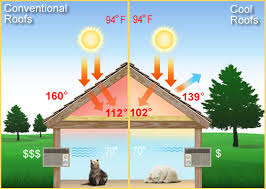Debunking Some Myths About Cool Roofs
Cool roofing is becoming popular because of numerous benefits that it offers, including substantial savings in electric bills to cool the interior of a building. Cool roofs are made up of roofing materials with a high degree of reflectance that reduce the absorption of heat on the structure. The use of cool roofs could reduce the temperature of a building by up to 60° Fahrenheit.
While the concept of a cool roof has been around for years, misconception still exists about its features. Here are some of them:
1. Reflective Roofs Must Use Only the White Color
While white is the most reflective color, it is not correct to state that all reflective roofs can only be white. Cool roofs are available in different colors, each one presenting different degree of reflectivity against sunlight. In fact, darker colors could be treated with pigments that reflect sunlight in the near-infrared spectrum. Since 50 percent of the sun’s energy is in the near-infrared spectrum, the reflectance of pigment-treated colored roofs becomes significant.
2. Phthalates are Dangerous to Our Health
Many cool roofs use PVC products that reflect sunlight and absorb less heat. To make PVC products flexible, phthalates are mixed in during the production process. Roofing membranes, tarps and tubing are flexible because of phthalates. Based on studies and use of phthalates for more than 50 years, the substance has not been shown to be harmful to humans if it is used as intended.
3. The Energy-Saving Feature of a White Roof is Ineffective During Winter
The idea is based on a seemingly-logical reasoning that materials that can keep buildings cool during summer would also do the same in winter. The fact is not that simple. For instance, a dark roof that absorbs heat during summer does so considerably less during winter.
For reflective roofs, environmental factors mitigate its cooling effects in winter. Take, for example, the angle of the sun during winter. The low angle poses very minimal heating potential during this period. The mostly overcast skies and shorter days significantly reduce the time during which the roof absorbs heat from the sun.
Most commercial buildings demand less energy for heating compared to the higher demand for cooling to counter heat created from equipment use and human activity. The energy cost to heat a structure in order to achieve a fixed comfort level is significantly lower than the energy cost needed to attain a comfort level for cooling.
4. Cool Roofs Cost More than Conventional Roofs
Making a roof cool incurs very minimal costs. In fact, cool roofs translate to substantial savings in the long run.
